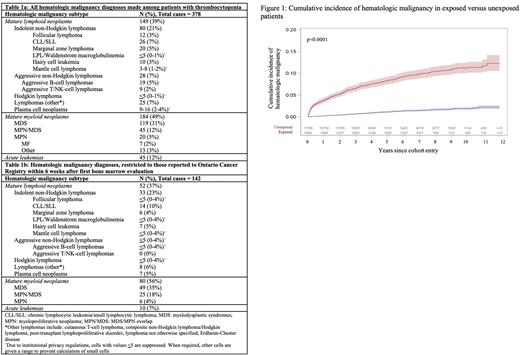Abstract
Background: In older patients, performing a bone marrow aspirate/biopsy (BM) during consideration of the diagnosis of immune thrombocytopenia (ITP) is controversial, and international hematology societies conflict in their recommendations due to limited evidence. Although ITP is more common in patients older than 60 years, the prevalence of hematologic malignancy also rises with age. The objective of this study was to determine whether isolated thrombocytopenia in patients aged 60 years and older is associated with the diagnosis of a hematologic malignancy, compared to matched patients without thrombocytopenia.
Methods: We performed a retrospective population-based propensity-matched cohort study using linked health administrative data in Ontario, Canada. We included patients aged 60 years and older. Exposed patients were those with an internist or hematologist billing a consultation for thrombocytopenia, with laboratory-documented thrombocytopenia (platelet count <100x109/L) within 6 months prior to the consultation date (index date). Unexposed patients were those who never had specialist consultation for thrombocytopenia, who had all platelet counts >100x109/L within 6 months prior to index date. Patients were excluded if they had an abnormal hemoglobin or white blood cell count at index date, or a history of cancer, cirrhosis, or inherited bleeding or coagulation disorder. Exposed and unexposed patients were matched 1:4 on age at index (within 1 year), sex, and a propensity-score (within 0.2 standard deviations). The primary outcome was diagnosis of hematologic malignancy using a competing-risk of death model. The secondary outcome was all-cause death. We performed pre-specified stratified analyses on the primary outcome by age (<80; >80 years), sex, duration of thrombocytopenia prior to specialist consultation (<1; >1 year), severity of thrombocytopenia at index date or closest laboratory test prior to index date (<30x109/L; >30x109/L), and patients treated with corticosteroids (prednisone or dexamethasone) within 2 weeks of index date versus patients not treated with corticosteroids. We also performed pre-specified sensitivity analyses on the primary and secondary outcome to compare hazard ratios (HR) among exposed patients stratified by platelet count on index date or closest platelet count prior to index date (<10x109/L, 10-29x109/L, 30-49x109/L, 50-99x109/L).
Results: We matched 4,390 exposed to 17,556 unexposed patients from January 1, 2009 to December 31, 2019. Among exposed patients, 378 (8.6%, 95% CI 7.8-9.5; 19.1/1000 person years (PY), 95% CI 17.1-21.0) were diagnosed with hematologic malignancy over 3.91 years of follow-up, compared to 204 unexposed patients (1.2%, 95% CI 1.0-1.3; 2.5/1000PY, 95% CI 2.2-2.8) over 4.05 years of follow-up. In the first year after consultation, the HR for being diagnosed with a hematologic malignancy was 15.5 (95% CI 11.3-21.4, p<0.0001, Figure 1) in exposed patients compared to unexposed. In subsequent years the HR was 5.3 (95% CI 4.4-6.6, p<0.0001, Figure 1). This relationship persisted in stratified analyses by sex, age, severity or duration of thrombocytopenia, and patients treated with corticosteroids within 2 weeks of consultation. Among exposed patients, the majority of hematologic malignancy diagnoses in the first year after index date were registered within 6 weeks of a BM (88%), while in subsequent years 45% of diagnoses were registered within 6 weeks of a BM. The most common hematologic cancer diagnosed in exposed patients was MDS (31%) (Table 1). Over half of cases of hematologic malignancy found in the exposed cohort would have been immediately actionable with disease-specific therapy.
In terms of overall survival, 1,277 exposed patients (29.1%, 95% CI 27.8-30.5; 61.1/1000PY, 95% CI 57.8-64.5) and 3,663 unexposed patients (20.9%, 95% CI 20.3-21.5; 44.7/1000PY, 95% CI 43.3-46.2) died during the follow-up period (HR 1.4; 95% CI 1.3-1.5, p<0.0001).
In a sensitivity analysis, there was no difference in the rate of hematologic malignancy diagnosis or rate of death based on severity of thrombocytopenia.
Conclusions and Relevance: This population-based study demonstrates a strong association between thrombocytopenia and hematologic malignancy in patients aged 60 years and older. These data support the use of BM upfront in outpatient specialist consultation for isolated thrombocytopenia in older patients.
Disclosures
Sholzberg:Pfizer: Other: Unrestricted research funding ; Novartis: Honoraria; Amgen: Honoraria, Other: Unrestricted research funding; Medison: Honoraria.
Author notes
Asterisk with author names denotes non-ASH members.


This feature is available to Subscribers Only
Sign In or Create an Account Close Modal